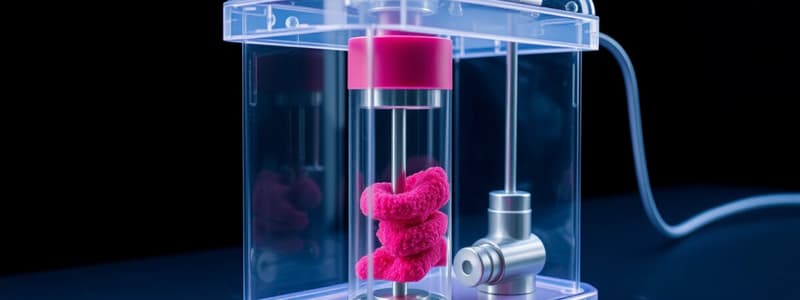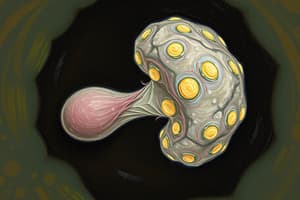Podcast
Questions and Answers
What type of transport does a sodium ion use when moving from the outside to the inside of a cell?
What type of transport does a sodium ion use when moving from the outside to the inside of a cell?
- Facilitated diffusion via a Na+ ion channel (correct)
- Active transport via a pump
- Osmosis
- Simple diffusion
How does a sodium ion move from the inside to the outside of a cell?
How does a sodium ion move from the inside to the outside of a cell?
- Passive transport using ion channels
- Active transport via the sodium-potassium transporter pump (correct)
- Simple diffusion
- Facilitated diffusion
What characterizes the transport of potassium ions moving from the inside to the outside of a cell?
What characterizes the transport of potassium ions moving from the inside to the outside of a cell?
- Active transport through a pump
- Simple diffusion
- Facilitated diffusion via K+ ion channels (correct)
- Osmosis
Which of the following accurately describes the movement of water molecules across a membrane?
Which of the following accurately describes the movement of water molecules across a membrane?
What type of transport is utilized by carbon dioxide molecules as they move across a membrane?
What type of transport is utilized by carbon dioxide molecules as they move across a membrane?
How do potassium ions move from the outside to the inside of a cell against their concentration gradient?
How do potassium ions move from the outside to the inside of a cell against their concentration gradient?
What type of transport mechanism do oxygen molecules primarily use to enter a cell?
What type of transport mechanism do oxygen molecules primarily use to enter a cell?
Which of the following ions is primarily moved by an active transport mechanism in cells?
Which of the following ions is primarily moved by an active transport mechanism in cells?
What role does the nucleolus play in the cell?
What role does the nucleolus play in the cell?
Which of the following best describes a gene?
Which of the following best describes a gene?
Which type of transport is primarily involved in moving ions across the cell membrane against their concentration gradient?
Which type of transport is primarily involved in moving ions across the cell membrane against their concentration gradient?
What is the primary function of the nuclear envelope?
What is the primary function of the nuclear envelope?
What is the main function of the sodium-potassium transporter pump?
What is the main function of the sodium-potassium transporter pump?
How do glucose molecules typically enter a cell?
How do glucose molecules typically enter a cell?
Which of the following describes a feature of ribosomes?
Which of the following describes a feature of ribosomes?
In which direction do molecules typically move during passive transport?
In which direction do molecules typically move during passive transport?
What is the process by which fluid droplets move into the cell called?
What is the process by which fluid droplets move into the cell called?
Which statement regarding large proteins is true?
Which statement regarding large proteins is true?
What mechanism is involved in the transport of solid particles into the cell?
What mechanism is involved in the transport of solid particles into the cell?
When ions are involved in cell transport, what defines an ion?
When ions are involved in cell transport, what defines an ion?
What type of transport occurs when substances move from an area of low concentration to high concentration?
What type of transport occurs when substances move from an area of low concentration to high concentration?
What is the primary difference between passive diffusion and facilitated diffusion?
What is the primary difference between passive diffusion and facilitated diffusion?
Flashcards are hidden until you start studying
Study Notes
Sodium-Potassium Transporter Pump
- Operates against concentration gradient, moving sodium ions outside and potassium ions inside the cell.
- Active transport mechanism requires energy input.
Transport of Glucose, Amino Acids, and Fatty Acids
- Utilize facilitated diffusion through protein carriers.
- Move from high to low concentration, does not require energy.
Proteins and Vesicular Transport
- Large proteins synthesized by the cell are exported through active transport.
- Transport occurs via secretory vesicles in a process called exocytosis.
Cell Membrane Transport Mechanisms
- Pinocytosis: Active transport mechanism for fluid droplets entering the cell.
- Phagocytosis: Active mechanism for solid particles entering the cell.
Passive Transport Mechanisms
- Oxygen and Carbon Dioxide Molecules: Move via simple diffusion, from high to low concentration.
- Water Molecules: Move through osmosis, primarily via aquaporins, from high to low concentration.
- Sodium Ions: Passively move through Na+ ion channels from high to low concentration.
Active Transport for Ions
- Sodium ions moving inside to outside the cell utilizes the sodium-potassium transporter pump (active).
- Potassium ions can passively exit through K+ ion channels (high to low concentration) or actively enter the cell from outside.
Genetic Material in the Cell
- Each chromosome consists of thousands of genes, which are segments containing information for protein synthesis.
- The nucleolus is responsible for producing ribosomes, important for protein production and cell function.
Summary of Ion Movement
- Sodium and potassium ions have distinct transport mechanisms: passive (facilitated diffusion) and active (sodium-potassium transporter).
- Concentration gradients dictate the movement of various molecules across the cell membrane.
Studying That Suits You
Use AI to generate personalized quizzes and flashcards to suit your learning preferences.




